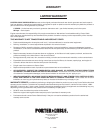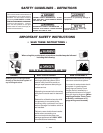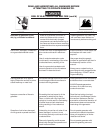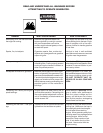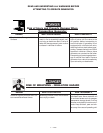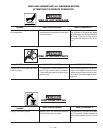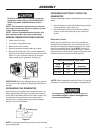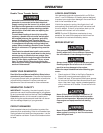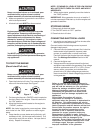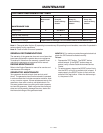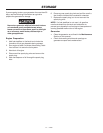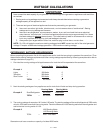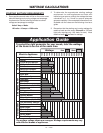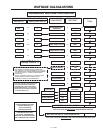
11 — ENG
OPERATION
KNOW YOUR GENERATOR
Read this General Manual and Safety Rules before
operation of your Generator. Compare the illustration
in your parts manual with your generator to familiarize
yourself with the location of various controls and
adjustments. Save all manuals for future references.
GENERATOR CAPACITY
IMPORTANT: Exceeding the rated capacity of your
generator can result in serious damage to your genera-
tor and connected electrical devices. See the Wattage
Calculation section in this manual to assist you in
determining the appliances and tools that can be ran
with the wattage capacity of your generator.
CIRCUIT BREAKERS
Each receptacle has a circuit breaker to protect the
generator from overloading. If the circuit breaker trips,
unplug all electrical loads from the generator. Let the
circuit breaker cool down. Push circuit breaker button
to reset.
BEFORE START UP
This generator has been shipped from the
factory without oil in the crankcase. Operating
the unit without oil can damage the engine.
Always check engine oil level before every start.
Running engine low of oil or out of oil could
result in serious damage to the engine.
Follow the steps listed below before starting gen-
erator:
1. Check engine oil. Refer to the Engine Operator's
Manual for correct grade and quantity of oil.
2. Check fuel level, fill as required. Make sure genera-
tor is turned off and has been allowed time to cool
down. Use clean, fresh, regular unleaded gasoline
with a minimum of 87 octane. Do not mix oil with
gasoline.
Never fill fuel tank completely. Fill tank to 1/2"
below the bottom of the filler neck to provide
space for fuel expansion. Wipe any fuel spillage
from engine and equipment before starting
engine.
Never fill fuel tank indoors. Never fill fuel tank
when engine is running or hot. Do not smoke
when filling fuel tank.
Potential hazards exist when a portable electric
generator is connected to the main electrical
supply coming into the house. It is at that point
that the electrical generator could feed back into
the utility company's system causing possible
electrocution of workers who are repairing the
electrical lines.
To avoid back feeding of electricity into utility
systems, a double-throw transfer switch must
be installed between the generator and utility
power. The Double-Throw Transfer Switch
should be installed by a licensed electrician and
in compliance with all state and local electrical
codes. (When installing a Double-Throw Transfer
Switch, a minimum of 10 gauge wiring must be
used.)
The electrician should also install a sub-panel to
isolate the circuits you would want to use during
an emergency or electrical power outage. Your
generator will not be large enough to handle the
load of all the lights, appliances, TV, etc. at one
time. To select which items to run during the
electrical power outage, see Wattage Calculation
section in this manual.
Double Throw Transfer Switch
LOW OIL SHUTDOWN
Your generator engine is equipped with Low Oil Shut-
down. Low Oil Shutdown is a safety device designed
to protect your engine from damage in the event the oil
level in the crankcase is low.
If while the engine is running, the oil gets low, it will
automatically shut itself down and will not restart until
the oil is added. If the oil is low before start-up, the
generator will not start until oil is added.
NOTE: The Low Oil Shutdown mechanism is very
sensitive. You must fill the engine to the full mark on
the dipstick to inactivate this safety device.



